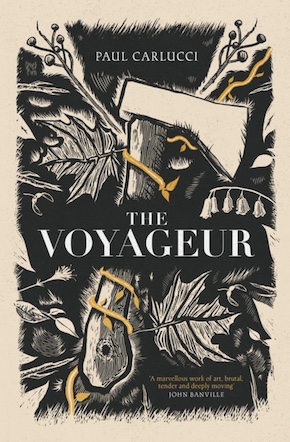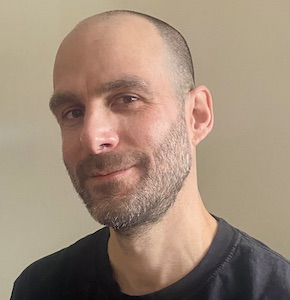An experiment in history
by Paul Carlucci
Set in 1830s British North America, my debut novel, The Voyageur, is about an orphan named Alex who falls in love with a rum-guzzling fur trader and follows the older man into the hallucinogenic wilderness of the Great Lakes, only to be shot in the stomach when a trading-post robbery goes off the rails. Present in the store is Samuel Beaumont, an American war surgeon; he saves Alex’s life, but the wound heals into a fistula, a creepy fusing of organs – in this case the skin and the stomach. Alex is left with a hole in his side, his stomach at the inner end of the dark and pulsating canal. Moving forward from this premise, the book explores the difficulties of seizing agency in a fiercely competitive world where people use all manner of deception to get both what they need and what they think they need.
The idea came from a historical starting point: the true story of Alexis St. Martin and William Beaumont. In 1822, when he was a healthy young fur trader in his twenties, St. Martin was accidentally shot in the stomach while queuing up inside a trading post on Mackinac Island in Lake Huron. Someone at the counter was handling a gun and accidentally fired it off. Beaumont saved St. Martin’s life, but as in the novel, the wound healed into a gastric fistula. St. Martin was destitute, and he accepted an invitation to live in Beaumont’s home, eventually agreeing to work as a servant once he recovered enough to undertake a few chores. In the weeks immediately following the injury, Beaumont watched in amazement as all the food St. Martin ate came out the hole in his side, and an ambition took hold.
At the time, the workings of the stomach weren’t surely known. Was digestion a mechanical process, with the stomach physically crushing whatever fell inside? Was it chemical, with acids of some kind dissolving our meals? Or was it something else altogether? In St. Martin, Beaumont saw an opportunity to get some answers, and he embarked on a series of experiments, dangling food items inside the fistula, pulling them back out and observing whatever changes they had undergone. The two had a complicated on-and-off relationship that lasted many years, the former keen to continue his research and the latter conceding only when he was broke.
Did Beaumont allow the wound to heal that way? Could he have sewn it up and saved St. Martin a lifetime of discomfort? We don’t really know, but the cynical – and probably accurate – perception is that the doctor contrived the situation to work in his favour, because after subjecting St. Martin to a plethora of painful experiments, he confirmed the presence of hydrochloric acid in the stomach, which had been earlier theorised by physician and chemist William Prout. He then published his results and made his mark on medical history.
Beaumont, today remembered as the father of gastric physiology, died in 1853; he was sixty-seven. St. Martin lived well into his seventies, dying in his home province of Quebec almost thirty years later.
How do we relate to our bodies when we’re grievously injured? What role does injury play in power dynamics? How does it weaken us in some senses and empower us in others?”
I originally heard about this intense weirdness while walking my dog and listening to an episode of Radiolab. It crept into my imagination, pressing buttons and pulling levers, and I decided to try writing a novel about it, although I soon learned I wouldn’t be the first. There’s a straightforward, high-fidelity account called Open Wound by Jason Karlawash, an American doctor, centring Beaumont’s perspective and his contributions to medical science. But I was more interested in the story from St. Martin’s point of view, and it was really just the kernel of it I wanted to work with. How do we relate to our bodies when we’re grievously injured? What role does injury play in power dynamics? How does it weaken us in some senses and empower us in others? How does a precursor of mental injury influence the way people treat us when we get physically hurt? How does our self-concept change as we cope with sudden injury and later adjust to the lasting changes it imposes? And how can we use our injuries to our advantage, claiming some share of independence even as others try to keep us dependent?
I’d tried writing novels before – one about a dysfunctional couple who didn’t know they were gods, another about an industry baron who builds a nationwide railway – but they were both awful, and short fiction had been my wheelhouse instead. I liked condensed storytelling, usually trying to capture only part of an arc and leaving the rest implied. I wasn’t really sure where The Voyageur would go when I started, but it was exciting to have an idea that presented itself on a larger scale, and I instantly had a lot of fun working on the voice, an artifice of old-timey diction and structure, and the world, a mix of magic realism, body horror and historical fiction.
I took extensive liberties with the personalities of both St. Martin and Beaumont, not quite inventing them from scratch but also not worrying too much about who they actually were, ultimately tweaking their names to set them loose in the reality I was trying to develop. And I expanded the focus, with only one of the novel’s four parts expressly concerned with the relationship between doctor and patient. I wound up with an extensive cast that includes not just Alex, Beaumont and the latter’s wife, but also a ghost that lives in Alex’s fistula, an Odawa brave in exile with his widowed sister and her son, a gunslinging tavern keeper, a slave who escapes the American South by swimming all the way up the Mississippi River, a heavily tattooed carnival ringmaster and a menagerie of seedy fur traders, at least one of whom is probably a loup-garou (a French-Canadian werewolf). The story takes readers from the wharves of Old Montreal down the waterways of Eastern Canada. From there, it moves across the border into Michigan Territory, then back north to the Town of York, now known as Toronto, before settling once again in Lower Canada, much of which became our modern-day Quebec.
I truly hope readers don’t think I’ve done something slightly – or, worse, extremely – wrong with this absurdly inaccurate retelling of history. I’m not fully sure if people approach historical fiction the way I do: with no expectation of truth in the traditional sense. In the genre, different books make different commitments to the historical record, but all of them take at least a bit of creative licence. And anyway, the objective truth of a thing can’t be expressed even in non-fiction, which is also a product of selection and omission, bias and agenda. I think what I got out of writing The Voyageur is less a certainty about how the doings of human digestion were discovered and more a soft, nebulous understanding of how people interact with each other to pursue those kinds of ambitions, or really any kind of ambition at all, particularly when other people’s pursuits are sometimes conflicting and just as impassioned. To the extent that the book finds readers, I hope they take away something similar.
—

Paul Carlucci is the author of three collections of stories. He lives in Ottawa. His work has been published in print and online journals and magazines including The New Quarterly, The Malahat Review, Grain and Apocalypse Confidential. The Voyageur, his debut novel and his first book to be released outside Canada, is published by Swift Press in hardback and eBook.
Read more
paul-carlucci.com
@_SwiftPress

